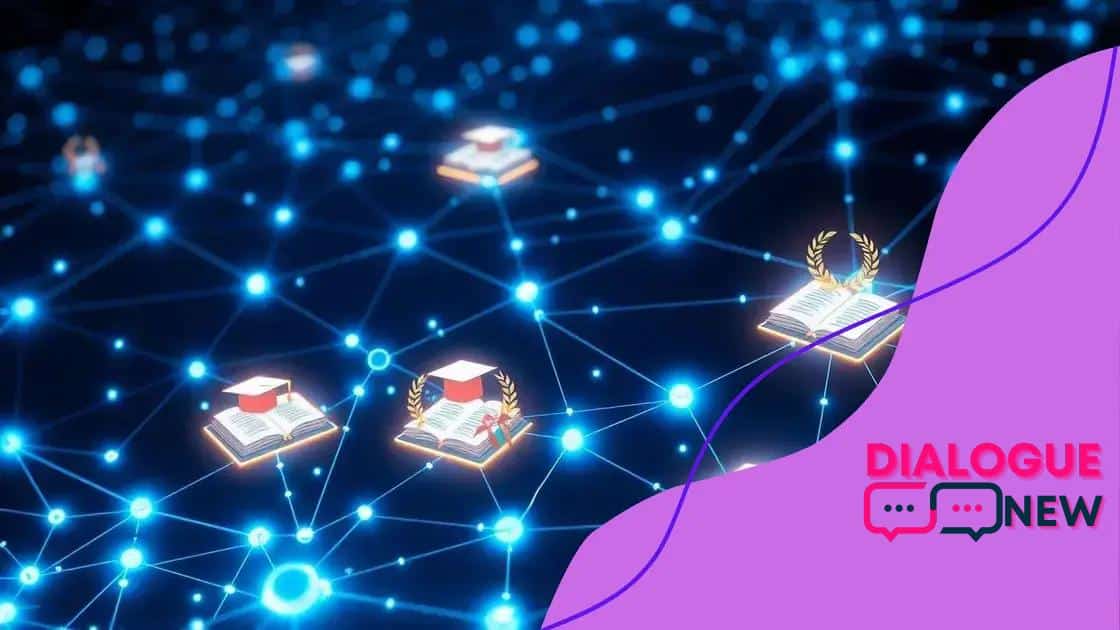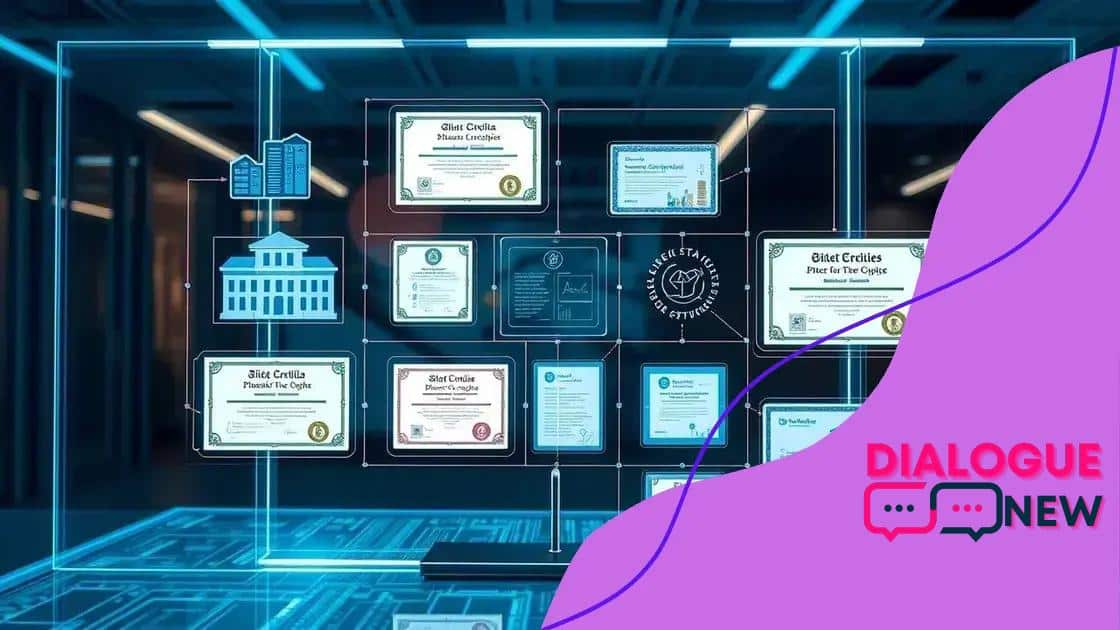Blockchain in academic credential verification: a new approach

Blockchain in academic credential verification enhances security and efficiency by providing a decentralized, tamper-proof system for validating educational credentials quickly and securely.
Blockchain in academic credential verification is changing the way institutions validate qualifications. Imagine a system where your degree can be verified instantly and securely, reducing fraud significantly. Curious how this works? Let’s dive in!
Understanding blockchain technology
Understanding blockchain technology is essential for grasping its role in various sectors, especially in academic credential verification. At its core, blockchain is a decentralized digital ledger that records transactions across many computers. This ensures that records cannot be altered retroactively without the consensus of the network.
The basic principle of blockchain is transparency, which fosters trust among users. Each transaction is encrypted and linked to the previous one, forming a chain of secure data. This not only enhances security but also reduces the chances of fraud.
Key Features of Blockchain
Several key features distinguish blockchain from traditional databases:
- Decentralization: There is no single point of control, which enhances security.
- Immutability: Once data is recorded, it cannot be changed, ensuring the integrity of records.
- Transparency: All transactions are visible to all network participants, promoting accountability.
Blockchain is particularly useful in the context of academic credentials. Institutions can issue degrees on a blockchain, making it easy to verify authenticity. This not only streamlines the verification process but also builds confidence among employers and educational bodies.
Furthermore, utilizing blockchain in academic systems can simplify the transfer of credits between institutions. By maintaining a shared and secure record of student achievements, barriers between schools are lowered, benefiting students.
As we look towards the future, understanding blockchain technology paves the way for innovation in how we handle credentials. Its potential to transform the educational landscape cannot be overlooked, promising a system that is robust, transparent, and efficient.
Benefits of blockchain for credential verification
The benefits of blockchain for credential verification are transforming how institutions manage and validate educational records. One major advantage is enhanced security. Each transaction is encrypted and added to a decentralized ledger, making data tampering virtually impossible. This ensures that academic credentials are authentic and trustworthy.
Another significant benefit is efficiency. Traditional credential verification can be a slow process, often taking days or even weeks. With blockchain, verification can happen almost instantly. This saves time for both institutions and students seeking employment.
Improved Trust
Blockchain fosters a higher level of trust among stakeholders. When institutions issue degrees on a blockchain, employers can view the proof directly, reducing the chances of fraudulent claims. This transparency builds confidence not only in the credentials but also in the educational institutions that provide them.
- Streamlined Processes: Automating the verification process reduces administrative workloads.
- Cost Savings: Blockchain can lower costs associated with paper records and lengthy verification processes.
- Access to Records: Stakeholders can easily access verified records without unnecessary delays.
Moreover, utilizing blockchain for credential verification promotes lifelong learning. Individuals can continuously add new achievements to their blockchain record, allowing them to showcase their skills in a dynamic job market. This approach encourages continuous education and professional development.
Adopting blockchain technology can also simplify international education verification. Institutions worldwide can access verified credentials securely. This creates a global standard for academic verification, opening doors for students across borders.
Case studies of successful implementations

Many organizations are discovering the benefits of blockchain in credential verification. Let’s explore some case studies that highlight successful implementations of this transformative technology.
One notable example is the University of Malta. The university partnered with a blockchain company to issue diplomas on the blockchain. This allows employers to verify graduates’ credentials in real-time. This initiative not only reduces fraud but also streamlines the hiring process for employers.
Innovative Solutions in Verifiable Credentials
Another significant implementation comes from a collaboration between the city of Zug in Switzerland and a blockchain technology provider. They created a system that allows residents to verify their identity and qualifications using blockchain. This eliminates lengthy verification procedures and enhances trust between parties.
- University of Malta: Issued diplomas on the blockchain for quick verification.
- Zug, Switzerland: Developed a system for identity verification using blockchain technology.
- Edinburgh University: Collaborated with a tech firm to create a platform for storing academic records securely.
In the corporate world, companies like IBM are leveraging blockchain to verify employee credentials. They developed an application that securely manages employee records, making it easy to validate skills and achievements. This not only increases trust but also improves onboarding processes for new hires.
Furthermore, the tool created by MIT allows students to own and control their educational credentials within a blockchain. By doing this, students can share their qualifications securely with potential employers without relying on third parties, making the process more efficient and secure.
These case studies demonstrate how blockchain is being used effectively across various sectors to enhance credential verification. The technology enables faster, safer, and more reliable verification processes.
Challenges faced in adoption
While there are many benefits to using blockchain for credential verification, several challenges can hinder its adoption. Understanding these challenges is crucial for organizations looking to implement this technology effectively.
One of the primary obstacles is the complexity of blockchain technology. Many educational institutions and organizations may find it challenging to understand how to integrate blockchain into their existing systems. This complexity can lead to resistance to change, as stakeholders might feel overwhelmed by the new technology.
Technical Barriers to Implementation
Another significant challenge is the technical skill gap. Many institutions may lack the necessary expertise to build or maintain blockchain systems. This can create delays in implementation as they may need to hire new staff or invest in training.
- Cost of Implementation: Setting up a blockchain system can be expensive. This includes costs related to software, infrastructure, and skilled personnel.
- Data Privacy Concerns: Institutions may worry about how sensitive student data will be protected on a public blockchain.
- Interoperability Issues: Different blockchain systems may not work together seamlessly, making data sharing difficult.
Furthermore, the regulatory environment can also pose challenges. Many regions still lack clear regulations concerning blockchain technology and its use in education. This uncertainty can deter organizations from making the necessary investments in blockchain systems.
Additionally, there is a lack of standardized protocols for issuing and verifying credentials using blockchain. This can create confusion among institutions and employers about how to interpret and trust the data being shared.
As a result, despite the promising potential of blockchain technology, these challenges must be addressed to enable wider adoption in credential verification.
Future trends in credential verification
Future trends in credential verification are heavily influenced by advancements in blockchain technology and artificial intelligence. As more institutions recognize the importance of secure and efficient validation processes, we can expect significant changes in this area.
One of the most exciting trends is the increasing integration of AI with blockchain systems. AI can help analyze vast amounts of data quickly, making the verification process smoother and more accurate. This synergy will help institutions respond to the verification requests much faster.
Personalized Learning Portfolios
Another trend on the horizon is the development of personalized learning portfolios. These portfolios will allow individuals to store and share their educational achievements securely on a blockchain. Students can showcase skills and credentials that enhance their job prospects while maintaining control over their data.
- Enhanced Security: As blockchain technology evolves, security measures will become more robust, protecting sensitive information.
- Global Standards: The establishment of international standards for credential verification will facilitate cross-border educational validation.
- Decentralized Identity Solutions: Individuals will manage their identities more directly, reducing the reliance on traditional educational institutions for verification.
Additionally, as employers seek candidates with verified skills, job platforms may incorporate blockchain. This will provide candidates with a way to display their verified academic and professional credentials directly on their profiles.
We will also see an increase in partnerships between educational institutions and tech companies. These collaborations will drive innovation in credential verification, making it an integral part of the educational experience. This can enhance learning outcomes and ensure that students are better prepared for the job market.
In conclusion, the integration of blockchain technology into credential verification is paving the way for a more secure, efficient, and trustworthy system. As we move into the future, innovations in this area will enhance the way institutions manage education credentials and how employers verify qualifications. With ongoing collaborations and advancements, we can expect a world where credentials are not only verified quickly but also stored securely, giving individuals greater control over their educational achievements. By addressing challenges and embracing new trends, educational institutions and employers can create a dynamic environment that fosters trust and accountability in credential verification.
\n\n
\n
FAQ – Frequently Asked Questions about Blockchain in Credential Verification
What is blockchain technology?
Blockchain technology is a decentralized digital ledger that records transactions securely and transparently across multiple computers.
How does blockchain enhance credential verification?
Blockchain increases the security and efficiency of credential verification by allowing instant, tamper-proof access to verified educational records.
What are the main challenges in adopting blockchain for credential verification?
Challenges include the complexity of the technology, costs associated with implementation, and concerns about data privacy.
What trends are shaping the future of credential verification?
Future trends include the integration of AI with blockchain, personalized learning portfolios, and the establishment of global standards for credential validation.





